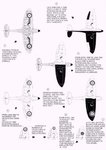Sir Francis
Airman
- 18
- May 27, 2007
Hey guys, some more paint scheme ques...
With the early war scheme with the black port underside, what was the light colour? White - Duck egg Blue? Im specifically looking at a Whirlwind of 263 Sqn and also a Buffalo of RNZAF 488 Sqn (Singapore).
Also while Im at it what humbrol colours are best for the upper surfaces of both planes? ie am assuming standard green brown as per Battle of Britain for the Whirlwind. (Humbrol ?) What about the Buffalo - Box art shows the green a lighter brighter shade?
cheers
With the early war scheme with the black port underside, what was the light colour? White - Duck egg Blue? Im specifically looking at a Whirlwind of 263 Sqn and also a Buffalo of RNZAF 488 Sqn (Singapore).
Also while Im at it what humbrol colours are best for the upper surfaces of both planes? ie am assuming standard green brown as per Battle of Britain for the Whirlwind. (Humbrol ?) What about the Buffalo - Box art shows the green a lighter brighter shade?
cheers





